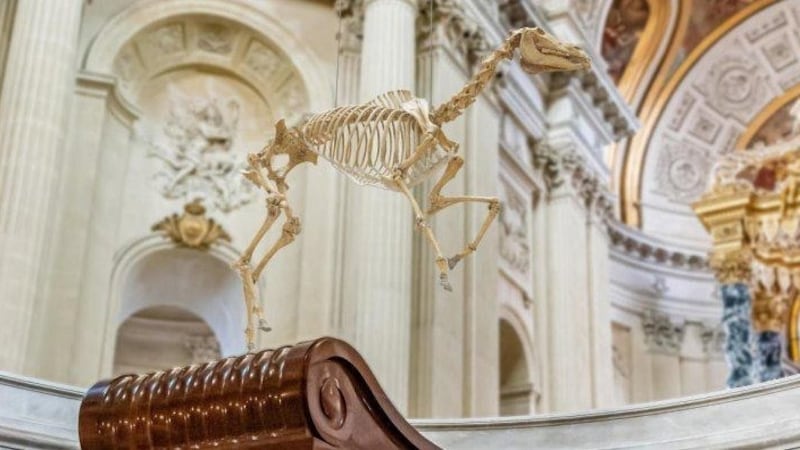Napoleon Bonaparte, emperor of the French, died 200 years ago Wednesday on the island of St Helena, more than 7,000km from Paris.
President Emmanuel Macron has shrugged off controversy surrounding the bicentennial and will commemorate France's favourite historical figure with a speech at the Académie Française and a wreath-laying at Napoleon's tomb at Les Invalides.
Napoleon's detractors say he was a megalomaniac dictator who left a trail of up to 2½ million dead across Europe. His defenders say Napoleon merely fought wars started by enemies of the revolution, then defended France against English-led coalitions of European enemies. By reconciling French royalists and revolutionaries, and establishing the country's systems of education, justice and government, he laid the foundations of modern France.

Napoleon seems to represent French national character, its rebelliousness but also its yearning for authority. He made his compatriots believe that France was destined to make history and impart civilisation to others.
His rise from modest origins to ruler of continental Europe also confirmed the French belief in meritocracy. If a scrappy Corsican boy who barely spoke French could become emperor at the age of 35, then any French person could become anything.
Most of all, Napoleon gave the French glory. Notoriously brave in battle, he said: “Death is nothing, but to live vanquished and without glory is to die every day.” He won 77 out of 86 military battles, a 90 per cent success rate.
He was a genius at self-promotion, transforming even defeats into tales of daring. He commissioned fashionable artists to portray him as a dashing general.
Legend building
As a prisoner of the British in St Helena, he constructed his own legend through the memoirs he dictated to Count Emmanuel de Las Cases. "The martyrdom I knew in St Helena has taken from me the image of a tyrant," Napoleon told his companion General Henri-Gatien Bertrand. When he died, Horace Vernet painted the emperor rising from his tomb, Christ-like, circled in light. Replicas of Napoleon's death mask could long be found in homes across France.

In The Man Who Took Himself for Napoleon, author Laure Murat writes that Napoleon is the most common subject of delusional disorders, more than Jesus Christ, Jeanne d'Arc or Louis XIV. In 1840, the year Napoleon's ashes were repatriated from St Helena, 14 would-be emperors were hospitalised in one Paris asylum alone.
Napoleon mania is not specific to France. In 1997 the US billionaire Bill Gates purchased a love letter from Napoleon to Josephine for the equivalent of more than €1 million. In 2014 a Korean paid €1.8 million for one of Napoleon's two-cornered hats. A plate from his porcelain service on St Helena can fetch hundreds of thousands at auction.
Wellington's troops captured Napoleon's favourite horse – named after the battle he had won at Marengo – at Waterloo and took him back to England. Marengo's skeleton was preserved at the National Army Museum in London. For the bicentennial, French artist Pascal Convert constructed a replica. "Bringing the horse from the last defeat towards the tomb of its rider is a ritual," Convert said. He suspended the skeleton above Napoleon's tomb, Pegasus-like.
Napoleon fans launched a petition titled “No to the profanation of the tomb of the Emperor Napoleon 1st”.

"Rehumanise Napoleon by suspending a plastic horse's skeleton above his tomb? You have got to be kidding!" tweeted Thierry Lentz, director of the Napoleon Foundation.
Slavery controversy
The most serious controversy surrounding the commemoration is the fact that Napoleon re-established slavery in France, eight years after it was abolished by the revolution. Ethnic minority staff at La Villette, site of one of several bicentennial exhibitions, threatened to go on strike.
Louis-Georges Tin of the Representative Council of Black Associations in France, and academic Olivier Le Cour Grandmaison, published an opinion piece in Libération denouncing Wednesday’s commemoration as “a scandal and an outrage inflicted on millions of black victims who were deported and enslaved in horrible conditions”.
Marlene Daut, a professor at the University of Virginia who describes herself as "a black woman of Haitian descent and a scholar of French colonialism", denounced the French commemoration in the New York Times, calling Napoleon "France's biggest tyrant, an icon of white supremacy ... an irredeemable racist, sexist and despot." Defenders of Napoleon say he was a man of his time.
Macron, like Napoleon, came to power in his 30s. The former’s wife, Brigitte, is, like Josephine, an older woman who introduced her husband to society. Macron too wants to unify Europe, albeit not at the point of a sabre.











